方位介词 in on under的用法
- 格式:ppt
- 大小:675.50 KB
- 文档页数:19
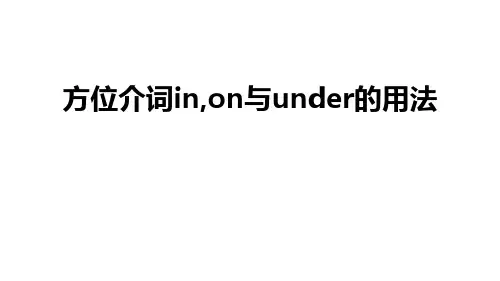
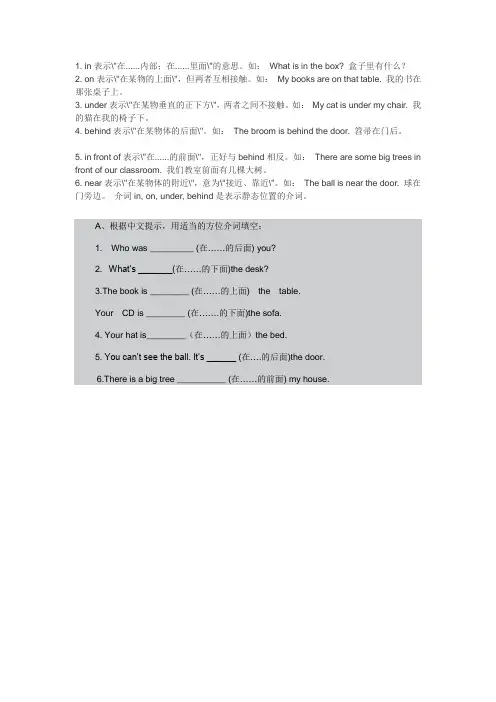
1. in表示\"在......内部;在......里面\"的意思。
如:What is in the box? 盒子里有什么?2. on表示\"在某物的上面\",但两者互相接触。
如:My books are on that table. 我的书在那张桌子上。
3. under表示\"在某物垂直的正下方\",两者之间不接触。
如:My cat is under my chair. 我的猫在我的椅子下。
4. behind表示\"在某物体的后面\"。
如:The broom is behind the door. 笤帚在门后。
5. in front of表示\"在......的前面\",正好与behind相反。
如:There are some big trees in front of our classroom. 我们教室前面有几棵大树。
6. near表示\"在某物体的附近\",意为\"接近、靠近\"。
如:The ball is near the door. 球在门旁边。
介词in, on, under, behind是表示静态位置的介词。
A、根据中文提示,用适当的方位介词填空:1. Who was _________ (在……的后面) you?2. What’s _______(在……的下面)the desk?3.The book is ________ (在……的上面) the table.Your CD is ________ (在…….的下面)the sofa.4. Your hat is________(在……的上面)the bed.5. You can’t see the ball. It’s ______ (在….的后面)the door.6.There is a big tree __________ (在……的前面) my house.。
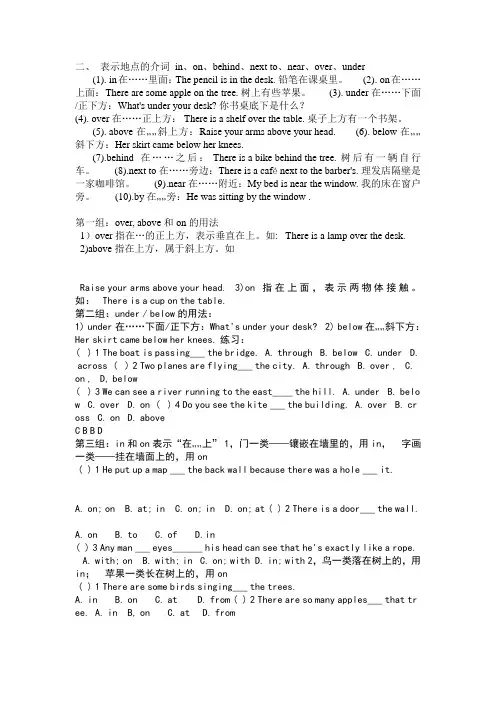
二、表示地点的介词 in、on、behind、next to、near、over、under(1). in在……里面: The pencil is in the desk. 铅笔在课桌里。
(2). on在……上面: There are some apple on the tree. 树上有些苹果。
(3). under在……下面/正下方:What's under your desk? 你书桌底下是什么?(4). over在……正上方: There is a shelf over the table. 桌子上方有一个书架。
(5). above 在……斜上方:Raise your arms above your head. (6). below 在……斜下方:Her skirt came below her knees.(7).behind在……之后: There is a bike behind the tree. 树后有一辆自行车。
(8).next to在……旁边:There is a café next to the barber's. 理发店隔壁是一家咖啡馆。
(9).near在……附近:My bed is near the window. 我的床在窗户旁。
(10).by 在……旁:He was sitting by the window .第一组:over, above和on的用法1)over指在…的正上方,表示垂直在上。
如: There is a lamp over the desk.2)above指在上方,属于斜上方。
如Raise your arms above your head.3)on指在上面,表示两物体接触。
如:There is a cup on the table.第二组:under/below的用法:1)under在……下面/正下方:What's under your desk?2)below在……斜下方:Her skirt came below her knees.练习:()1The boat is passing___the bridge. A.through B.below C.under D. across()2Two planes are flying___the city.A.through B.over, C. on,D,below()3We can see a river running to the east____the hill. A.under B.belo w C.over D.on()4Do you see the kite___the building. A.over B.cr oss C.on D.aboveC B B D第三组:in和on表示“在……上”1,门一类——镶嵌在墙里的,用in,字画一类——挂在墙面上的,用on()1He put up a map___the back wall because there was a hole___it.A.on;onB.at;inC.on;inD.on;at()2There is a door___the wall.A.onB.toC.ofD.in()3Any man___eyes______his head can see that he's exactly like a rope.A.with;onB.with;inC.on;withD.in;with2,鸟一类落在树上的,用in;苹果一类长在树上的,用on()1There are some birds singing___the trees.A.inB.onC.atD.from()2There are so many apples___that tr ee.A.in B,on C.at D.from第四组:in/on/to表示“接壤”B A B A BAB在A里——用in A和B相邻(接壤)——用on A和B不相邻(不接壤)——用to()1The United States is____the south of Canada and___the east of Japa n.A.to;inB.on;toC.in;besideD.at;on()2The man stood____the window,watching the boys playing outside.A.inB.byC.withD.to()3Japan lies____the east of China.A.on B/to C.in D.withB B BB第五组:at,in表示“在……”1)at表示较小的地点。
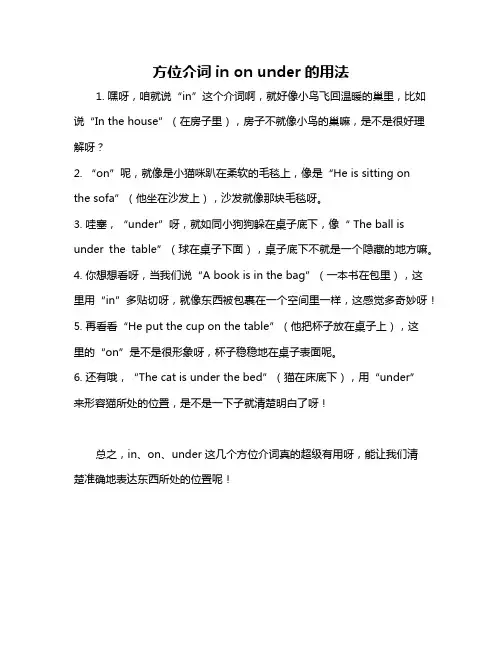
方位介词in on under的用法
1. 嘿呀,咱就说“in”这个介词啊,就好像小鸟飞回温暖的巢里,比如说“In the house”(在房子里),房子不就像小鸟的巢嘛,是不是很好理解呀?
2. “on”呢,就像是小猫咪趴在柔软的毛毯上,像是“He is sitting on
the sofa”(他坐在沙发上),沙发就像那块毛毯呀。
3. 哇塞,“under”呀,就如同小狗狗躲在桌子底下,像“ The ball is under the table”(球在桌子下面),桌子底下不就是一个隐藏的地方嘛。
4. 你想想看呀,当我们说“A book is in the bag”(一本书在包里),这
里用“in”多贴切呀,就像东西被包裹在一个空间里一样,这感觉多奇妙呀!
5. 再看看“He put the cup on the table”(他把杯子放在桌子上),这
里的“on”是不是很形象呀,杯子稳稳地在桌子表面呢。
6. 还有哦,“The cat is under the bed”(猫在床底下),用“under”
来形容猫所处的位置,是不是一下子就清楚明白了呀!
总之,in、on、under 这几个方位介词真的超级有用呀,能让我们清
楚准确地表达东西所处的位置呢!。
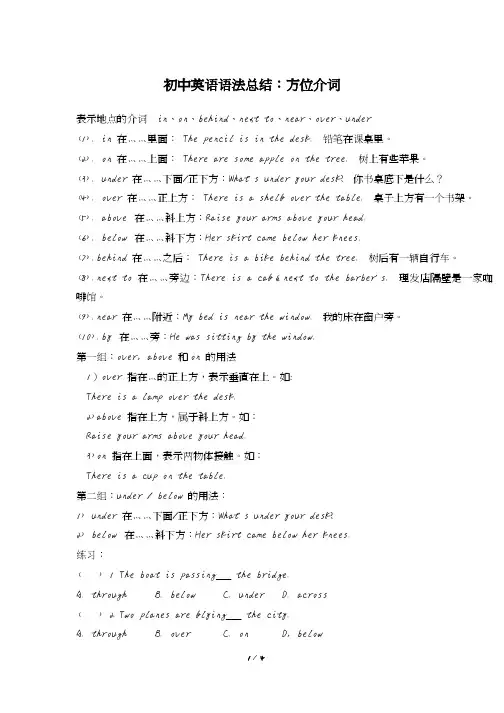
初中英语语法总结:方位介词表示地点的介词in、on、behind、next to、near、over、under(1). in 在……里面:The pencil is in the desk. 铅笔在课桌里。
(2). on 在……上面:There are some apple on the tree. 树上有些苹果。
(3). under 在……下面/正下方:What's under your desk? 你书桌底下是什么?(4). over 在……正上方:There is a shelf over the table. 桌子上方有一个书架。
(5). above 在……斜上方:Raise your arms above your head.(6). below 在……斜下方:Her skirt came below her knees.(7).behind 在……之后:There is a bike behind the tree. 树后有一辆自行车。
(8).next to 在……旁边:There is a café next to the barber's. 理发店隔壁是一家咖啡馆。
(9).near 在……附近:My bed is near the window. 我的床在窗户旁。
(10).by 在……旁:He was sitting by the window.第一组:over, above 和on 的用法1)over 指在…的正上方,表示垂直在上。
如:There is a lamp over the desk.2)above 指在上方,属于斜上方。
如:Raise your arms above your head.3)on 指在上面,表示两物体接触。
如:There is a cup on the table.第二组:under / below 的用法:1) under 在……下面/正下方:What's under your desk?2) below 在……斜下方:Her skirt came below her knees.练习:( ) 1 The boat is passing___ the bridge.A. throughB. belowC. underD. across( ) 2 Two planes are flying___ the city.A. throughB. overC. on D, below( ) 3 We can see a river running to the east____ the hill.A. underB. belowC. overD. on( ) 4 Do you see the kite ___ the building.A. overB. crossC. onD. above参考答案C B B D第三组:in 和on 表示“在……上”门一类——镶嵌在墙里的,用in字画一类——挂在墙面上的,用on( ) 1 He put up a map ___ the back wall because there was a hole ___ it.A. on; onB. at; inC. on; inD. on; at( ) 2 There is a door___ the wall.A. onB. toC. ofD. in( ) 3 Any man ___ eyes______ his head can see that he's exactly like a rope.A. with; onB. with; inC. on; withD. in; with鸟一类落在树上的,用in;苹果一类长在树上的,用on( ) 1 There are some birds singing___ the trees.A. inB. onC. atD. from( ) 2 There are so many apples___ that tree.A. in B, on C. at D. from第四组:in /on/ to 表示“接壤”第四组:in /on/ to 表示“接壤”B A B AB 在A 里——用in A 和B 相邻(接壤)——用onA BA 和B 不相邻(不接壤)——用to练习( ) 1 The United States is ____ the south of Canada and ___ the east of Japan.A. to; inB. on; toC. in; besideD. at; on( ) 2 The man stood ____the window, watching the boys playing outside.A. inB. byC. withD. to( ) 3 Japan lies____ the east of China.A. on B/ to C. in D. with参考答案B B B B第五组:at, in 表示“在……”1)at 表示较小的地点。
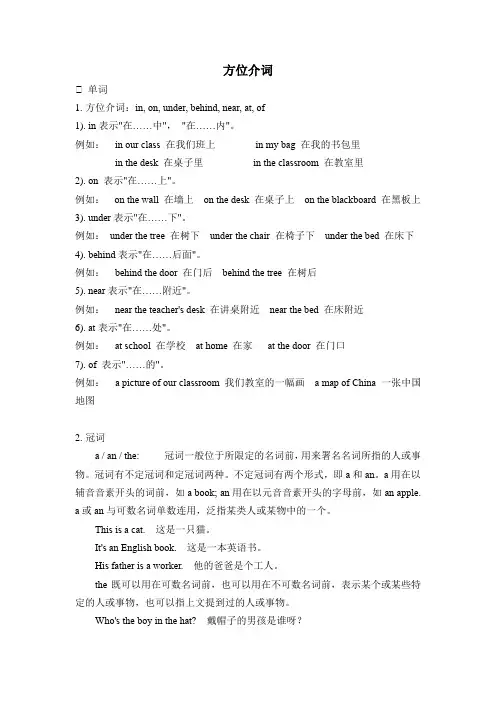
方位介词⑴单词1.方位介词:in, on, under, behind, near, at, of1). in表示"在……中","在……内"。
例如:in our class 在我们班上in my bag 在我的书包里in the desk 在桌子里in the classroom 在教室里2). on 表示"在……上"。
例如:on the wall 在墙上on the desk 在桌子上on the blackboard 在黑板上3). under表示"在……下"。
例如:under the tree 在树下under the chair 在椅子下under the bed 在床下4). behind表示"在……后面"。
例如:behind the door 在门后behind the tree 在树后5). near表示"在……附近"。
例如:near the teacher's desk 在讲桌附近near the bed 在床附近6). at表示"在……处"。
例如:at school 在学校at home 在家at the door 在门口7). of 表示"……的"。
例如: a picture of our classroom 我们教室的一幅画 a map of China 一张中国地图2.冠词a / an / the: 冠词一般位于所限定的名词前,用来署名名词所指的人或事物。
冠词有不定冠词和定冠词两种。
不定冠词有两个形式,即a和an。
a用在以辅音音素开头的词前,如a book; an用在以元音音素开头的字母前,如an apple. a或an与可数名词单数连用,泛指某类人或某物中的一个。
This is a cat. 这是一只猫。
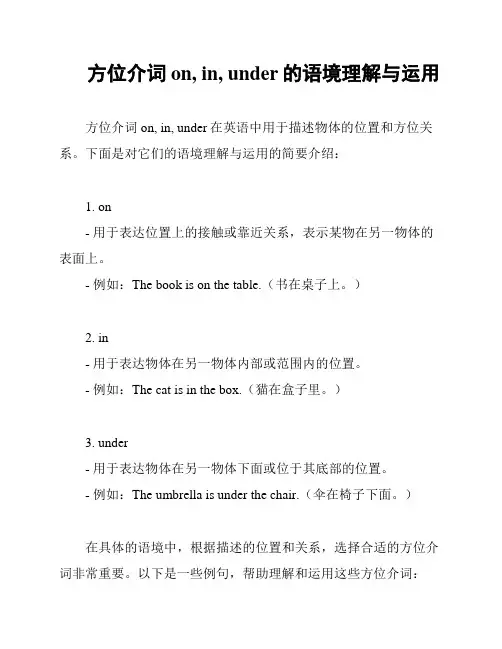
方位介词on, in, under的语境理解与运用
方位介词on, in, under在英语中用于描述物体的位置和方位关系。
下面是对它们的语境理解与运用的简要介绍:
1. on
- 用于表达位置上的接触或靠近关系,表示某物在另一物体的表面上。
- 例如:The book is on the table.(书在桌子上。
)
2. in
- 用于表达物体在另一物体内部或范围内的位置。
- 例如:The cat is in the box.(猫在盒子里。
)
3. under
- 用于表达物体在另一物体下面或位于其底部的位置。
- 例如:The umbrella is under the chair.(伞在椅子下面。
)
在具体的语境中,根据描述的位置和关系,选择合适的方位介词非常重要。
以下是一些例句,帮助理解和运用这些方位介词:
- The picture is hanging on the wall.(这幅图片挂在墙上。
)
- The car is parked in the garage.(汽车停在车库里。
)
- The pen is under the notebook.(钢笔在笔记本下面。
)
需要注意的是,方位介词的使用可能会因具体语境而有所变化,需要根据具体情况进行判断。
总结:
方位介词on, in, under在英语中用于描述物体的位置和方位关系。
理解和准确运用这些介词是掌握英语语法和表达的基本要求。
根据具体语境选择合适的方位介词,可以更准确地描述物体的位置
和关系。
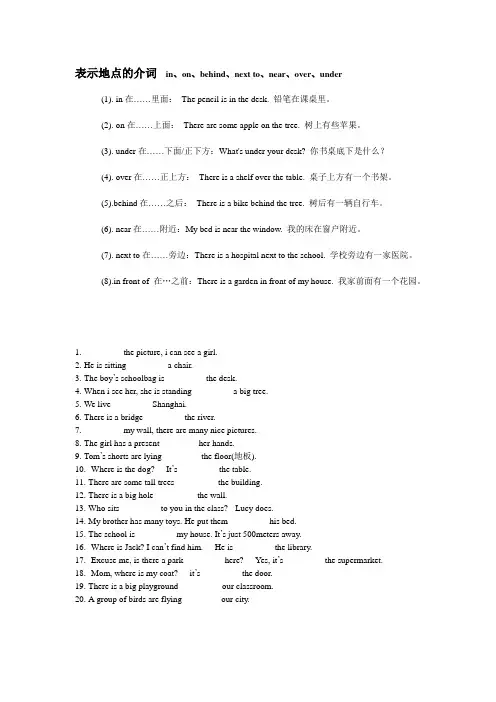
表示地点的介词in、on、behind、next to、near、over、under(1). in在……里面:The pencil is in the desk. 铅笔在课桌里。
(2). on在……上面:There are some apple on the tree. 树上有些苹果。
(3). under在……下面/正下方:What's under your desk? 你书桌底下是什么?(4). over在……正上方:There is a shelf over the table. 桌子上方有一个书架。
(5).behind在……之后:There is a bike behind the tree. 树后有一辆自行车。
(6). near在……附近:My bed is near the window. 我的床在窗户附近。
(7). next to在……旁边:There is a hospital next to the school. 学校旁边有一家医院。
(8).in front of 在…之前:There is a garden in front of my house. 我家前面有一个花园。
1._________the picture, i can see a girl.2.He is sitting _________a chair.3.The boy’s schoolbag is _________the desk.4.When i see her, she is standing _________a big tree.5.We live _________Shanghai.6.There is a bridge _________the river.7._________my wall, there are many nice pictures.8.The girl has a present_________her hands.9.Tom’s shorts are lying_________the floor(地板).10.-Where is the dog? -It’s _________the table.11.There are some tall trees _________ the building.12.There is a big hole _________ the wall.13.Who sits _________to you in the class? - Lucy does.14.My brother has many toys. He put them _________his bed.15.The school is _________my house. It’s just 500meters away.16.-Where is Jack? I can’t find him. -He is _________the library.17.-Excuse me, is there a park _________here? -Yes, it’s _________the supermarket.18.-Mom, where is my coat? -it’s _________the door.19.There is a big playground _________ our classroom.20.A group of birds are flying_________our city.。
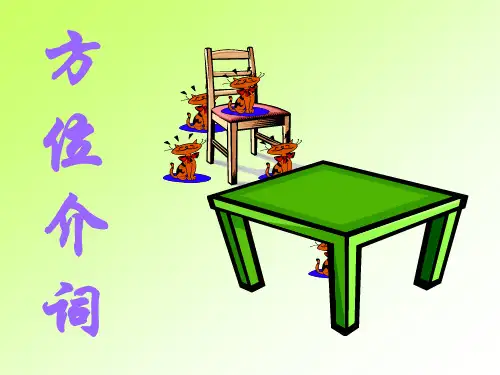
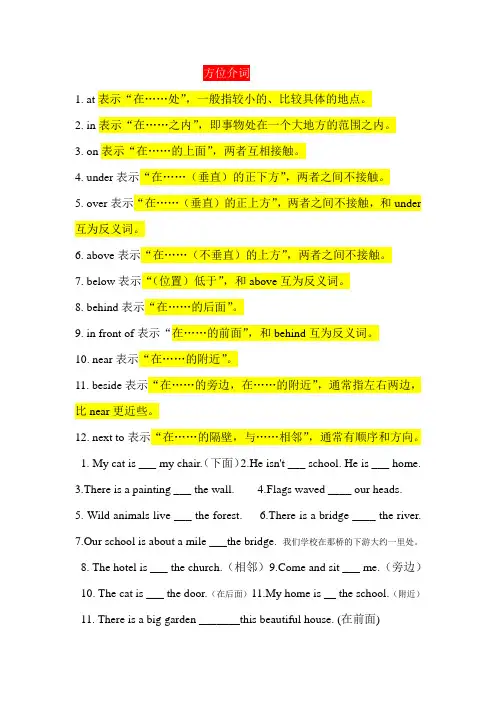
1. at表示“在……处”,一般指较小的、比较具体的地点。
2. in表示“在……之内”,即事物处在一个大地方的范围之内。
3. on表示“在……的上面”,两者互相接触。
4. under表示“在……(垂直)的正下方”,两者之间不接触。
5. over表示“在……(垂直)的正上方”,两者之间不接触,和under 互为反义词。
6. above表示“在……(不垂直)的上方”,两者之间不接触。
7. below表示“(位置)低于”,和above互为反义词。
8. behind表示“在……的后面”。
9. in front of表示“在……的前面”,和behind互为反义词。
10. near表示“在……的附近”。
11. beside表示“在……的旁边,在……的附近”,通常指左右两边,比near更近些。
12. next to表示“在……的隔壁,与……相邻”,通常有顺序和方向。
1. My cat is ___ my chair.(下面)2.He isn't ___ school. He is ___ home.3.There is a painting ___ the wall.4.Flags waved ____ our heads.5. Wild animals live ___ the forest.6.There is a bridge ____ the river.7.Our school is about a mile ___the bridge. 我们学校在那桥的下游大约一里处。
8. The hotel is ___ the church.(相邻)e and sit ___ me.(旁边)10. The cat is ___ the door.(在后面)11.My home is __ the school.(附近)11. There is a big garden _______this beautiful house. (在前面)。
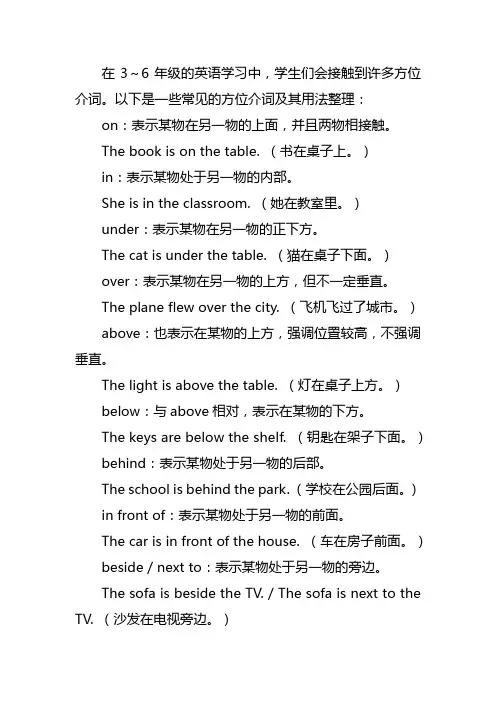
在3~6年级的英语学习中,学生们会接触到许多方位介词。
以下是一些常见的方位介词及其用法整理:on:表示某物在另一物的上面,并且两物相接触。
The book is on the table. (书在桌子上。
)in:表示某物处于另一物的内部。
She is in the classroom. (她在教室里。
)under:表示某物在另一物的正下方。
The cat is under the table. (猫在桌子下面。
)over:表示某物在另一物的上方,但不一定垂直。
The plane flew over the city. (飞机飞过了城市。
)above:也表示在某物的上方,强调位置较高,不强调垂直。
The light is above the table. (灯在桌子上方。
)below:与above相对,表示在某物的下方。
The keys are below the shelf. (钥匙在架子下面。
)behind:表示某物处于另一物的后部。
The school is behind the park. (学校在公园后面。
)in front of:表示某物处于另一物的前面。
The car is in front of the house. (车在房子前面。
)beside / next to:表示某物处于另一物的旁边。
The sofa is beside the TV. / The sofa is next to the TV. (沙发在电视旁边。
)between:表示某物处于另外两个物体之间。
The school is between the bank and the post office. (学校在银行和邮局之间。
)among:表示某物处于三个或更多物体之间。
She found her book among the stack of papers. (她在那一堆文件中找到了她的书。
)across from:表示某物在另一物的对面。
方位介词英语
方位介词是指用来表示方向、位置、移动等概念的介词。
在英语中常用的方位介词包括in、on、at、under、over、between、among、behind、beside、with等。
这些方位介词在句子中的使用需要根据具体情境来确定,例如:
- In表示在一个封闭的空间内或时间段的内部,如in the room、in the morning。
- On表示在一个平面或表面上,如on the table、on the wall。
- At表示在某个地点或时间点,如at the park、at 2 o'clock。
- Under表示在某物的下方,如under the bed、under the tree。
- Over表示在某物的上方,如over the bridge、over the clouds。
- Between表示在两个物体或位置之间,如between the two chairs、between the river and the mountain。
- Among表示在多个物体或位置之间,如among the flowers、among the crowd。
- Behind表示在某物的后面,如behind the door、behind the car。
- Beside表示在某物的旁边,如beside the river、beside the bookshelf。
- With表示伴随或一起,如with my friends、with a cup of tea。
在学习和使用方位介词时,需要注意它们的用法和意义,并且要根据具体语境进行正确的运用。
初中英语语法总结:⽅位介词(有答案)初中英语语法总结:⽅位介词表⽰地点的介词in、on、behind、next to、near、over、under(1). in在……⾥⾯:The pencil is in the desk. 铅笔在课桌⾥。
(2). on在……上⾯:There are some apple on the tree. 树上有些苹果。
(3). under在……下⾯/正下⽅:What's under your desk? 你书桌底下是什么?(4). over在……正上⽅:There is a shelf over the table. 桌⼦上⽅有⼀个书架。
(5). above 在……斜上⽅:Raise your arms above your head.(6). below 在……斜下⽅:Her skirt came below her knees.(7).behind在……之后:There is a bike behind the tree. 树后有⼀辆⾃⾏车。
(8).next to在……旁边:There is a café next to the barber's. 理发店隔壁是⼀家咖啡馆。
(9).near在……附近:My bed is near the window. 我的床在窗户旁。
(10).by 在……旁:He was sitting by the window.第⼀组:over, above和on的⽤法1)over指在…的正上⽅,表⽰垂直在上。
如:There is a lamp over the desk.2)above指在上⽅,属于斜上⽅。
如:Raise your arms above your head.3)on指在上⾯,表⽰两物体接触。
如:There is a cup on the table.第⼆组:under / below的⽤法:1) under在……下⾯/正下⽅:What's under your desk?2) below 在……斜下⽅:Her skirt came below her knees.练习:( ) 1 The boat is passing___ the bridge.A. throughB. belowC. underD. across( ) 2 Two planes are flying___ the city.A. throughB. overC. on D, below( ) 3 We can see a river running to the east____ the hill.A. underB. belowC. overD. on( ) 4 Do you see the kite ___ the building.A. overB. crossC. onD. above参考答案C B B D第三组:in 和on表⽰“在……上”门⼀类——镶嵌在墙⾥的,⽤in字画⼀类——挂在墙⾯上的,⽤on( ) 1 He put up a map ___ the back wall because there was a hole ___ it. A. on; on B. at; in C. on; in D. on; at ( ) 2 There is a door___ the wall.A. onB. toC. ofD. in( ) 3 Any man ___ eyes______ his head can see that he's exactly like a rope.A. with; onB. with; inC. on; withD. in; with鸟⼀类落在树上的,⽤in;苹果⼀类长在树上的,⽤on( ) 1 There are some birds singing___ the trees.A. inB. onC. atD. from( ) 2 There are so many apples___ that tree.A. in B, on C. at D. from第四组:in /on/ to表⽰“接壤”第四组:in /on/ to表⽰“接壤”B A B AB 在A⾥——⽤in A和B相邻(接壤)——⽤onA BA和B不相邻(不接壤)——⽤to练习( ) 1 The United States is ____ the south of Canada and ___ the east of Japan.A. to; inB. on; toC. in; besideD. at; on( ) 2 The man stood ____the window, watching the boys playing outside. A. in B. by C. with D. to ( ) 3 Japan lies____ the east of China.A. on B/ to C. in D. with参考答案B B B B第五组:at, in表⽰“在……”1)at表⽰较⼩的地点。